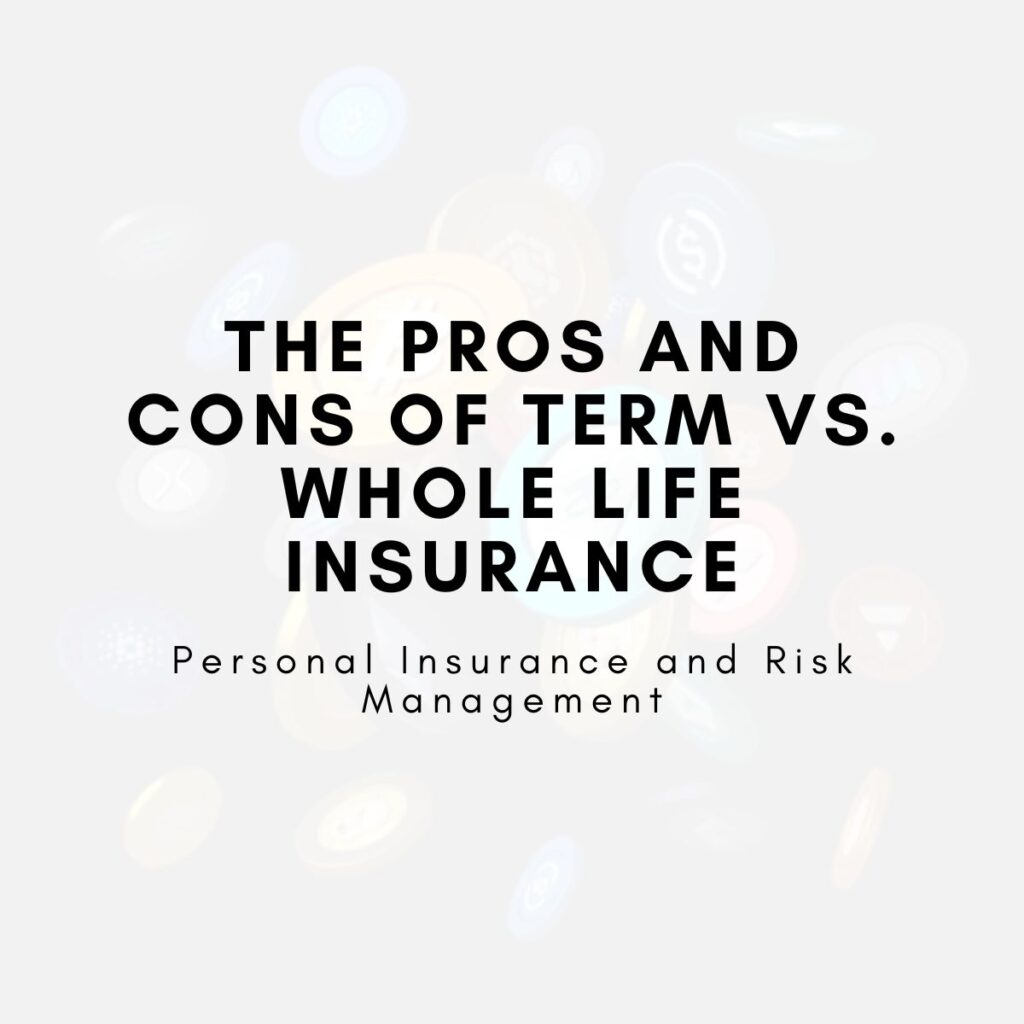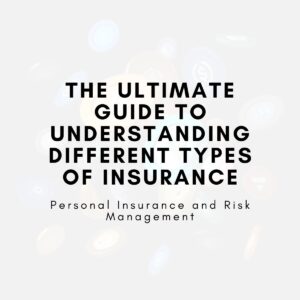
What are the pros and cons of term vs. whole life insurance?
When deciding between term and whole life insurance, it’s crucial to understand their differences. Term life insurance offers affordable coverage for a fixed period, making it ideal for those seeking temporary financial protection. Whole life insurance, on the other hand, provides lifetime coverage and a cash value component, but it’s more expensive. Each option has unique advantages and disadvantages depending on your financial goals, family needs, and budget.
Summary Table: The Pros and Cons of Term vs. Whole Life Insurance
| Section | Summary | Key Tips | Examples |
|---|---|---|---|
| Understanding Term Life Insurance | Term life offers affordable coverage for a fixed period, typically 10–30 years, without a cash value. | Ideal for those seeking temporary protection for large financial obligations like mortgages. | John buys a 20-year term policy for $30/month to ensure his kids’ financial security if something happens to him. |
| Whole Life Insurance Overview | Whole life insurance provides lifetime coverage with a cash value component that grows over time. | Choose if you want lifelong coverage and an investment component. | Sarah pays $150/month for a $250,000 policy and builds $50,000 in cash value over 20 years. |
| Key Differences | Term life is temporary and cheaper, while whole life offers lifelong coverage and savings but costs more. | Term is better for temporary needs; whole life suits long-term estate planning. | Mark pays $50/month for term life, while Alex pays $400/month for whole life due to different financial goals. |
| Choosing the Right Policy | Consider your financial goals, budget, and long-term plans before deciding on a policy type. | Term is best for budget-conscious individuals; whole life suits those with higher disposable income. | Jane opts for a term policy to cover her kids, while Alex chooses whole life for estate planning. |
| Can You Combine Both Policies? | Combining term and whole life can balance affordability and long-term protection. | Laddering can provide both cost-effective temporary coverage and lifelong security. | Tom combines a $500,000 term policy with a $250,000 whole life policy for balanced coverage. |
This table summarizes the core aspects of term vs. whole life insurance, highlighting their key features, benefits, and drawbacks. It also offers practical examples and actionable tips for choosing the right policy based on individual needs and financial goals. Use this guide to make an informed decision about your life insurance strategy.
Introduction
Choosing the right life insurance policy is an essential part of financial planning. While both term and whole life insurance can help protect your loved ones in case of an unexpected event, they serve different purposes and come with distinct benefits and costs. In this guide, we will explore the key differences between term and whole life insurance, weigh their pros and cons, and help you decide which option is best for your situation. Whether you’re planning to protect your family, build wealth, or secure a legacy, understanding these two types of life insurance can lead to better decision-making.
Understanding Term Life Insurance
What Is Term Life Insurance?
Term life insurance provides coverage for a specified period, usually ranging from 10 to 30 years. If the policyholder passes away during the term, the beneficiaries receive a death benefit. Unlike whole life insurance, term policies do not accumulate cash value, making them more affordable.
Pros of Term Life Insurance
- Affordability – Term life premiums are significantly lower than whole life insurance.
- Simple and Easy to Understand – With no investment component, term life is straightforward.
- Temporary Coverage for Specific Needs – Ideal for covering temporary needs like mortgage payments or children’s education.
Example: John, a 35-year-old father of two, buys a 20-year term policy with a $500,000 death benefit for $30 per month. This ensures his family’s financial stability if something happens to him before his kids become financially independent.
Cons of Term Life Insurance
- No Cash Value – Once the term ends, you get no return unless you renew or convert the policy.
- Premiums Increase with Age – Renewal rates can rise significantly as you age.
- Limited Coverage Period – If you outlive the policy term, you must purchase new coverage at higher costs.
Whole Life Insurance: An Overview
What Is Whole Life Insurance?
Whole life insurance provides coverage for the policyholder’s entire life as long as premiums are paid. It includes a cash value component that grows over time on a tax-deferred basis, which can be borrowed against or withdrawn under certain conditions.
Pros of Whole Life Insurance
- Lifetime Coverage – Whole life ensures that beneficiaries receive a payout regardless of when the policyholder dies.
- Cash Value Accumulation – Over time, the policy builds cash value, offering a savings component.
- Fixed Premiums – Unlike term policies, whole life premiums remain constant throughout the policyholder’s life.
Example: Sarah purchases a whole life policy at age 30. She pays $150 per month for a $250,000 policy. By the time she is 50, her policy’s cash value has grown to $50,000, which she can borrow against for emergencies.
Cons of Whole Life Insurance
- High Premiums – Whole life policies can cost up to 10 times more than term policies for the same coverage amount.
- Complexity – With investment and borrowing options, whole life can be confusing.
- Lower Returns Compared to Other Investments – While the cash value grows, the rate of return may be lower than other long-term investments.
Key Differences Between Term and Whole Life Insurance
Coverage Duration
- Term Life: Provides coverage for a specific period (e.g., 10, 20, or 30 years).
- Whole Life: Offers lifelong coverage, provided premiums are paid.
Cost Comparison
- Term Life: More affordable due to the lack of cash value.
- Whole Life: Higher premiums because of the cash value and lifelong coverage.
Flexibility
- Term Life: Can be converted to whole life during the term, but lacks investment options.
- Whole Life: Offers borrowing options and potential dividends, but is less flexible for those seeking temporary coverage.
Example: If Mark, a 40-year-old, needs $1 million coverage for 20 years, he might choose a term policy for $50 per month. However, if he wants lifetime coverage and wealth-building, a whole life policy costing $400 per month might be better suited.
How to Choose the Right Policy for You?
Assess Your Financial Goals
- If you aim to cover specific financial obligations like a mortgage, term life may be best.
- If you want to build wealth and leave a legacy, whole life could be more suitable.
Consider Your Budget
- Term life is ideal for those on a tight budget seeking maximum coverage.
- Whole life suits those with higher disposable income who can afford the premiums.
Example: Jane, in her early 30s, with a limited budget, opts for a 20-year term policy to cover her young family. Meanwhile, her friend Alex, with a stable high income, buys whole life insurance for long-term wealth-building.
Evaluate Long-Term Needs
- For those planning early retirement or who expect a decrease in financial responsibilities, term life is often enough.
- Whole life is better for estate planning and ensuring coverage for lifelong dependents.
Can You Combine Term and Whole Life Insurance?
Combining both types of policies, known as laddering, allows policyholders to balance affordability and lifetime protection. You can use term life for temporary needs and whole life for long-term coverage.
Example: Tom, a business owner, buys a $500,000 20-year term policy to cover his mortgage and a $250,000 whole life policy for lifetime protection. This approach offers both flexibility and affordability.
Conclusion
Both term and whole life insurance have distinct advantages and disadvantages, and the right choice depends on your financial situation and goals. While term life is cost-effective and straightforward, whole life provides lifetime coverage and a cash value component. Carefully consider your budget, coverage needs, and long-term plans before making a decision. A combination of both policies may also be a viable strategy for those seeking a balanced approach.
Key Takeaways
- Term life insurance is ideal for temporary needs and is more affordable.
- Whole life insurance provides lifetime coverage but comes at a higher cost.
- Assess your financial goals, budget, and long-term needs before choosing.
- Combining both types of policies can offer the best of both worlds.
- Always consult a financial advisor to tailor an insurance plan that fits your unique situation.




